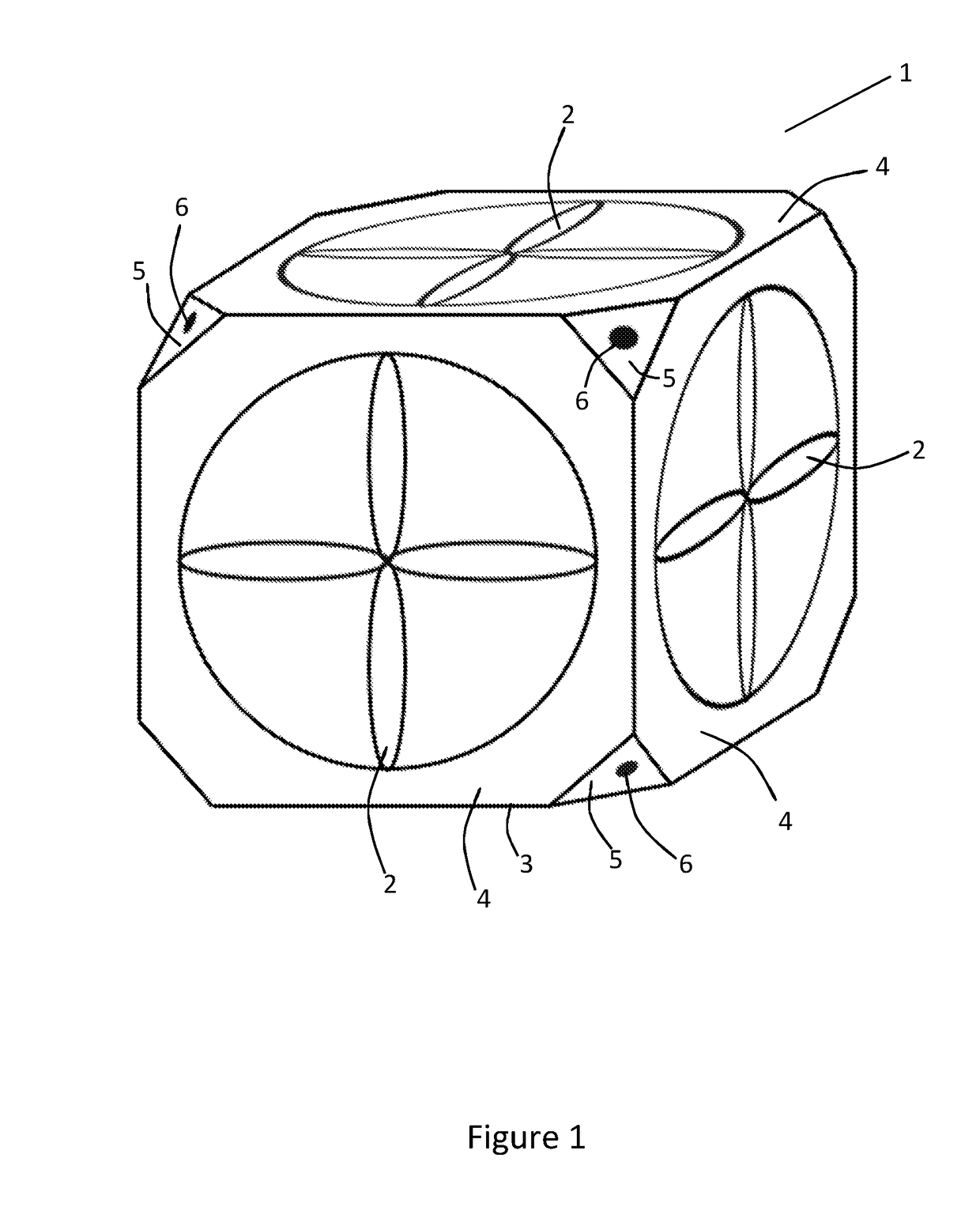Unmanned aerial vehicles
a technology for unmanned aerial vehicles and vehicles, applied in the direction of vehicle position/course/altitude control, process and machine control, instruments, etc., can solve the problems of increasing the number of moving parts in the uav, reducing the risk of damage to the rotors from such foreign objects, and avoiding the effect of affecting the flight
- Summary
- Abstract
- Description
- Claims
- Application Information
AI Technical Summary
Benefits of technology
Problems solved by technology
Method used
Image
Examples
first embodiment
[0095]It will be seen that the UAV 1 of the first embodiment comprises a frame 3 having the shape of a cube with chamfered corners. The frame 3 thus has six eight-sided faces 4 (three of which are hidden from view in FIG. 1) and eight smaller three-sided faces 5 (five of which are hidden from view in FIG. 1) at the corners of the notional cube.
[0096]For the plane of each of the eight-sided faces 4 of the frame 3 of the UAV 1 there is a respective rotor 2 such that the plane of the face is parallel with the plane of rotation of the rotor. Each rotor 2 is recessed into the surface of the frame, thereby protecting the rotor.
[0097]The rotors 2 are in the form of helicopter style rotors. The rotors 2 are each powered by an independent motor (a brushless motor, not shown) controlled using a MOSFET based controller (not shown). The rotors are connected to and driven by the motors using a circumferential drive mechanism (not shown). The drive mechanism may be arranged to drive the rotor via...
second embodiment
[0111]The body of the UAV 1 of the second embodiment is defined by a shell 7 having the shape of a dodecahedron with chamfered corners. The shell 7 has twelve ten-sided faces 8 (eight of which are hidden from view in FIG. 2) and twenty smaller three-sided faces 9 (thirteen of which are hidden from view in FIG. 2)—at the chamfered corners.
[0112]The plane of each of the ten-sided faces 8 of the shell 7 of the UAV 1 is parallel with the plane of rotation of one of the rotors 2. Each rotor 2 is recessed into the surface of the shell, thereby protecting the rotor.
[0113]The rotors 2 are each powered by an independent motor controlled using a MOSFET based controller (not shown). The rotors are connected to and driven by the motors using a circumferential drive mechanism (not shown).
[0114]The UAV 1 is equipped with twenty camera sensors 6 (seven of which are visible in FIG. 2), each one mounted on a three-sided face 9 of the shell 7. In other words, a camera is mounted on each chamfered cor...
third embodiment
[0116]The UAV 1 of the third embodiment also comprises a shell 10 having the shape of an icosahedron with chamfered corners. The shell 10 has twenty six-sided faces 11 (twelve of which are hidden from view in FIG. 3) and twelve five-sided faces 12 (seven of which are hidden from view in FIG. 3).
[0117]The plane of each of the six-sided faces 11 of the shell 10 of the UAV 1 is parallel with the plane of rotation of one of the rotors 2. Each rotor 2 is recessed into the surface of the shell, thereby protecting the rotor.
[0118]The rotors 2 are each powered by an independent motor controlled using a MOSFET based controller (not shown). The rotors are connected to and driven by the motors using a circumferential drive mechanism (not shown).
[0119]The UAV 1 is equipped with twelve camera sensors 6 (five of which are visible in FIG. 3), each one mounted on a five-sided face 12 of the shell 10. In other words, a camera is mounted on each chamfered corner of the icosahedron-shaped UAV 1.
[0120]...
PUM
 Login to View More
Login to View More Abstract
Description
Claims
Application Information
 Login to View More
Login to View More - R&D
- Intellectual Property
- Life Sciences
- Materials
- Tech Scout
- Unparalleled Data Quality
- Higher Quality Content
- 60% Fewer Hallucinations
Browse by: Latest US Patents, China's latest patents, Technical Efficacy Thesaurus, Application Domain, Technology Topic, Popular Technical Reports.
© 2025 PatSnap. All rights reserved.Legal|Privacy policy|Modern Slavery Act Transparency Statement|Sitemap|About US| Contact US: help@patsnap.com



